Passive Fiber-Optic Networks Emerge as Enterprise Solutions
Fiber-optic networks now cover the globe, displacing copper-based legacy networks that preceded them. Fiber has been pushed to the very edge of Local Area Network (LAN) communications, appearing over the last decade in the form of Passive Optical LAN (POL).
For enterprises, the availability of smaller, more-affordable versions of telecommunications carrier-grade gear enables fiber to serve as a core-to-edge solution — especially for large campuses or newly constructed facilities.
POL combines these technology advances and falling fiber-optic infrastructure costs to provide IT managers with the option of developing their own optical networks, specifically designed for their enterprise-specific communication needs.
Making the POL switch also often yields major cost savings and other operational benefits. A fiber-optic network requires significantly less cabling infrastructure, reduces power consumption for cooling and electrical systems, and takes up a smaller physical footprint — freeing up space for other revenue-generating purposes.
Basics of Passive Optical LAN
Passive Optical Network (PON) technology offers a futureproofed system for communication among multiple networked services, including voice, video, wireless access, security, surveillance, building controls, and building automation with Power over Ethernet (PoE).
Using optical fiber ports instead of traditional distribution- and access-layer network switches, PONs rely upon a largely “passive” network of optical splitters that separate light beams to network terminals.
A centrally located Optical Line Terminal (OLT) connects with hundreds or thousands of optical network terminals (ONTs). The fiber network replicates the downstream signal and combines the end-user traffic upstream.
The single strand of fiber from the OLT can be split to serve hundreds of ethernet ports, depending on the combination of ONTs supplied, the equipment manufacturer, and network bandwidth considerations.
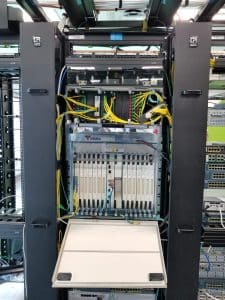
An Optical Line Terminal (pictured) aggregates and directs the PON’s optical signals.
Passive Optical Network Benefits
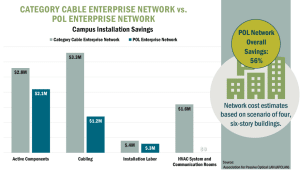
PONs offer higher bandwidth, facilitate future upgrades
Until now, enterprises have overcome bandwidth limitations of legacy copper by upgrading or replacing existing telecommunications networks.
Despite expectations that broadband networks will need to handle ever-increasing traffic, industry experts see no signs that enterprises must contend with bandwidth limits of single-mode optical fiber. In fact, bandwidth limitations are determined only by the electronic devices being used, not the fiber itself.
To upgrade from a 2.5G network to 10G or 40G, the electronics and signal-booster equipment are likely the only PON components that will need to be replaced.
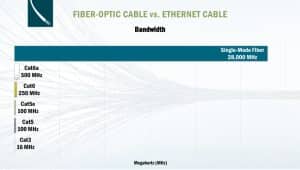
PONs extend over longer distances while reducing cabling costs.
Category-6 (CATx) copper cable can only extend 100 meters between active devices, regardless of bandwidth. Optical fiber cable can carry a signal up to 30 kilometers.
Single-mode fiber is dramatically less costly than twisted-pair copper cabling due to fiber-to-the-home advancements driving down commodity prices. As a result, enterprises that place fiber optic network devices at every endpoint can generate significant cost savings, even while reaching facilities farther from the central data center. Compared with active ethernet solutions, enterprises implementing PONs have experienced savings in cabling costs of 60 percent or more.
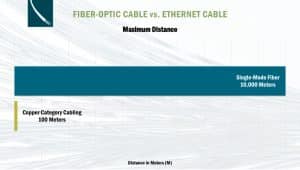
PONs use significantly less energy, avoid operational costs.
PONs reduce the need for powered devices, data center air conditioning, and other communications room infrastructure. ONTs can be locally powered from a nearby AC outlet or remotely powered from a DC source via hybrid fiber cabling with small copper conductors.
Overall, PONs involve fewer pieces of active equipment, minimizing the electrical and cooling loads for communications spaces that remain. Estimated power savings range between 30-65 percent.
The environmental benefit of a more energy-efficient communications system has prompted discussions of assigning Leadership in Energy and Environmental Design (LEED) building certification credits for POL implementation.
PONs require less space, make way for financial opportunities.
IT leaders may sometimes overlook the capital and operational costs associated with communication rooms. In addition to utility costs, communication rooms typically require security and fire-protection infrastructure — all of which can be avoided through a PON system, significantly reducing the total cost of network design.
With smaller conduits and cable trays, combined with the lack of support equipment, PONs reduce crowding of above-ceiling spaces and vertical chases. Splitters can go within communication rooms or office ceilings, beside electrical panels, or underground. ONTs can be mounted above or below office desks or flush-mounted in building walls.
Freeing up square footage allows enterprises to allocate these spaces for income-producing tenants or other beneficial uses. At airports, for example, where CATx-based LANs require locating communication rooms within 90 meters from end devices, PONs can help generate non-aeronautical revenue by expanding opportunities for high-end retail, concessions or other amenities.
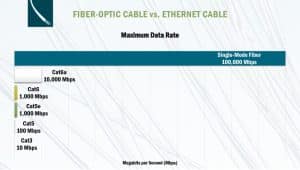
PONs avoid maintenance associated with cable repair and replacement.
When copper networks can no longer support increasing bandwidth demands, labor costs to upgrade the networks can be significant.
Installing new copper cable typically involves removal of ceiling tiles, drilling through doors and walls, and other invasive measures. This creates additional maintenance burdens, particularly at facilities such as hospitals where strict regulations control the spread of dust particles.
PONs need very little maintenance. Fiber optic cables have superior durability with lifetimes beyond 20 years. ONTs can operate without regular cleaning, inspections or testing. Edge devices can be upgraded to increase bandwidth capacity without the concern of the cabling becoming obsolete.
Enterprise Challenges and Limitations
Communication Room Requirements
A POL upgrade does not always result in the complete elimination of communication rooms. Some communications systems or equipment cannot be located centrally. Potential constraints include:
- Distributed Antenna Systems (DAS) requirements imposed by cellular carriers,
- Placement requirements for distributed video surveillance network video recorders (NVR),
- Digital signage head-end equipment, and
- Tenant or vendor communication room space limitations.
Reluctant IT Departments
Traditional, copper-based ethernet networks have served facilities well for decades. Contractors are generally more familiar with this tried-and-true network infrastructure. As a result, internal IT departments may need to be convinced that they should embrace a fundamental change to fiber-optic systems. Consider these approaches to overcome PON reluctance:
- Include key IT staff early in the planning and design discussions.
- Engage manufacturers to explain how PONs integrate with existing network ecosystems.
- Reinforce that PONs apply the same concepts as traditional ethernet networks, offering network engineers with opportunities to broaden their expertise to new technologies.
Fiber Optics Are Here to Stay
As technology innovation continues to advance, IT managers are in constant search for solutions to expand bandwidth, to bolster security, and to enhance reliability. At the same time, facility managers face mounting pressure to improve energy efficiency and to reduce capital and operating expenses.
PONs offer a future-proofed solution, overcoming copper cable’s inherent capacity, speed, distance and reliability limitations, all while providing an opportunity to lower operational costs. Because of these benefits, PON services are expanding, Industry watchers expect future growth will outpace conventional ethernet networks. Aviation, healthcare, education, and municipal government facilities will likely continue to be among the earliest adopters.
Although next-generation information technologies may be unpredictable, fiber-optic cables appear highly likely to serve as the conduit of future digital transformations — both outdoors and within enterprise facilities.


